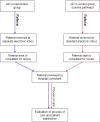Practical health co-operation - the impact of a referral template on quality of care and health care co-operation: study protocol for a cluster randomized controlled trial
- PMID: 23295103
- PMCID: PMC3551794
- DOI: 10.1186/1745-6215-14-7
Practical health co-operation - the impact of a referral template on quality of care and health care co-operation: study protocol for a cluster randomized controlled trial
Abstract
Background: The referral letter plays a key role both in the communication between primary and secondary care, and in the quality of the health care process. Many studies have attempted to evaluate and improve the quality of these referral letters, but few have assessed the impact of their quality on the health care delivered to each patient.
Methods: A cluster randomized trial, with the general practitioner office as the unit of randomization, has been designed to evaluate the effect of a referral intervention on the quality of health care delivered. Referral templates have been developed covering four diagnostic groups: dyspepsia, suspected colonic malignancy, chest pain, and chronic obstructive pulmonary disease. Of the 14 general practitioner offices primarily served by University Hospital of North Norway Harstad, seven were randomized to the intervention group. The primary outcome is a collated quality indicator score developed for each diagnostic group. Secondary outcomes include: quality of the referral, health process outcome such as waiting times, and adequacy of prioritization. In addition, information on patient satisfaction will be collected using self-report questionnaires. Outcome data will be collected on the individual level and analyzed by random effects linear regression.
Discussion: Poor communication between primary and secondary care can lead to inappropriate investigations and erroneous prioritization. This study's primary hypothesis is that the use of a referral template in this communication will lead to a measurable increase in the quality of health care delivered.
Trial registration: This trial has been registered at ClinicalTrials.gov. The trial registration number is NCT01470963.
Figures



Similar articles
-
Impact of referral templates on patient experience of the referral and care process: a cluster randomised trial.BMJ Open. 2016 Oct 24;6(10):e011651. doi: 10.1136/bmjopen-2016-011651. BMJ Open. 2016. PMID: 27797992 Free PMC article. Clinical Trial.
-
The effect of referral templates on out-patient quality of care in a hospital setting: a cluster randomized controlled trial.BMC Health Serv Res. 2017 Mar 7;17(1):177. doi: 10.1186/s12913-017-2127-1. BMC Health Serv Res. 2017. PMID: 28270128 Free PMC article. Clinical Trial.
-
Impact of referral templates on the quality of referrals from primary to secondary care: a cluster randomised trial.BMC Health Serv Res. 2015 Aug 29;15:353. doi: 10.1186/s12913-015-1017-7. BMC Health Serv Res. 2015. PMID: 26318734 Free PMC article. Clinical Trial.
-
A categorisation of problems and solutions to improve patient referrals from primary to specialty care.BMC Health Serv Res. 2018 Dec 20;18(1):986. doi: 10.1186/s12913-018-3745-y. BMC Health Serv Res. 2018. PMID: 30572898 Free PMC article. Review.
-
Identifying and managing patients at low risk of bowel cancer in general practice.BMJ. 2003 Aug 2;327(7409):263-5. doi: 10.1136/bmj.327.7409.263. BMJ. 2003. PMID: 12896939 Free PMC article. Review. No abstract available.
Cited by
-
Priority interventions to improve the management of chronic non-cancer pain in primary care: a participatory research of the ACCORD program.J Pain Res. 2015 Apr 30;8:203-15. doi: 10.2147/JPR.S78177. eCollection 2015. J Pain Res. 2015. PMID: 25995648 Free PMC article.
-
A Bibliometric Analysis and Visualization of Decision Support Systems for Healthcare Referral Strategies.Int J Environ Res Public Health. 2022 Dec 16;19(24):16952. doi: 10.3390/ijerph192416952. Int J Environ Res Public Health. 2022. PMID: 36554837 Free PMC article.
-
Impact of referral templates on patient experience of the referral and care process: a cluster randomised trial.BMJ Open. 2016 Oct 24;6(10):e011651. doi: 10.1136/bmjopen-2016-011651. BMJ Open. 2016. PMID: 27797992 Free PMC article. Clinical Trial.
-
Evaluation of the referral management systems (RMS) used by GP practices in Northumberland: a qualitative study.BMJ Open. 2019 Jul 9;9(7):e028436. doi: 10.1136/bmjopen-2018-028436. BMJ Open. 2019. PMID: 31289080 Free PMC article.
-
Educational interventions for health professionals managing chronic obstructive pulmonary disease in primary care.Cochrane Database Syst Rev. 2022 May 6;5(5):CD012652. doi: 10.1002/14651858.CD012652.pub2. Cochrane Database Syst Rev. 2022. PMID: 35514131 Free PMC article.
References
-
- Lohr KN. Medicare: A Strategy for Quality Assurance, Volume I. Washington, DC: The National Academy Press; 1990. - PubMed
-
- Institue of Medicine. To Err is Human: Building a Safer Health System. Washington, DC: National Academy Press; 2000.
-
- Varkey P, Reller MK, Resar RK. Basics of quality improvement in health care. Mayo Clinic Proceedings. 2007;82:735–739. - PubMed
-
- The Norwegian Directorat of Health. and it’s going to get better! National Strategy for Quality Improvement in Health and Social Services (2005–2015) Oslo: The Norwegian Directorat of Health; 2005.
Publication types
MeSH terms
Associated data
LinkOut - more resources
Full Text Sources
Other Literature Sources
Medical

